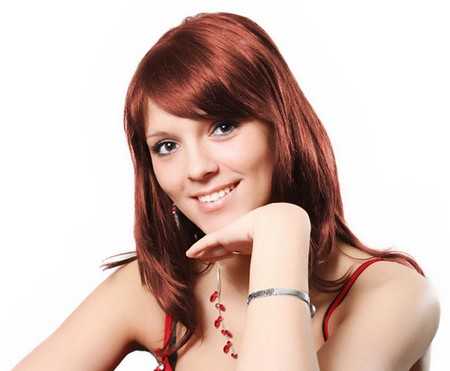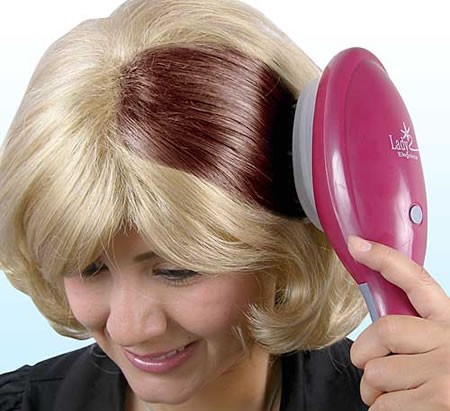Hair without color is like a face without make-up: it looks bare and undressed. So whether you want to brighten up lacklustre hair or totally reinvent yourself, color is the must-have hair accessory that no woman should be without.
Hair color lifts your whole appearance, revives jaded hair and is one of the most effective beautifiers. ‘With the latest technology and superior formulations, color has never been easier’, says Jo Hansford, the queen of color who has a star-studded clientele. At Jo’s exclusive Mayfair salon, you might find yourself sitting next to Carla Bruni, Melanie Griffith, Kate Winslet or another celebrity, which is exactly what happened to me when Jo performed her Midas touch on what I thought was an irreversible hair disaster. A few hours and a smattering of reverse lights and highlights later, I walked out with a mane that any celebrity would have been be proud of.
Advice on professional coloring
- Before coloring your hair, think about the upkeep involved and consider whether you can maintain the color (in terms of both cost and time). Highlights need redoing approximately every three months and permanent tints every four weeks.
- When choosing a colorist, find a salon with a color technician (a hairdresser who specializes in color) – rather than a general hairdresser who is a jack of all trades.
- A good hairdresser should give you a consultation and advise you against a color if he or she doesn’t think that it will work or suite you for that matter.
- Ask the colorist first to test your chosen color on small piece of your hair and then live with it for a couple of days before deciding if it’s really what you want.
Questions and Answers
Will color damage my hair?
Hair color has come on in leaps and bounds in the past few years and cotton-wool-like hair and green tinges are now things of the past. As so long as it is applied by a qualified hairdresser who is experienced in coloring, the process will not damage your hair. In fact, color can improve the texture of your hair, for it adds body to fine or limp hair, and depth and shine to dull hair.
How can I maintain my color or retouch my roots between salon visits?
If your hair color has faded, vegetable colors, color mousses or color-enhancing shampoos and conditioners, will liven it up. For those who lighten their hair and hence suffer from regrowth, Jo’s tip for defusing the darkness of the roots is to apply a tiny amount of dry-shampoo powder along the parting, dusting off any excess. Alternatively, you could try using a hair color-mascara wand, such as Dior’s Mascara Flash for Hair.
My hair color is a disaster – is there anything that can be done to rectify it?
According to Jo, with the exception of henna colors (which are virtually impossible to color over), most color disasters can be remedied. Jo recalls being faced with a Spanish model whose lime-green-tinged, straw-like hair needed to look fabulous (for a hair advertisement, no less) in a matter of hours. Jo succeeded.
How should I care for colored hair?
Keep your hair out of the sun because it can fade the color through oxidation. Use shampoos and conditioners that have been specially formulated for colored hair and apply a weekly intensive-conditioning treatment.
How do I choose the right color?
The majority of people arrive at the salon knowing what they want but, according to Jo, a hairdresser is more skilled and experienced to judge the color that will flatter the clients skin tone, than the client. In general, blonde shades suit most skin tones, but those with olive skin should avoid the lighter shades. Red tones are more tricky and do not suit those with pinkish coloring. And, whereas brunette shades suit most, raven hair can make some people look pallid and washed out.
Can I color my hair at home?
Doing it yourself may save money in the short term, but unless you are using a wash-in-wash-out formula it can be risky: ‘Most women end up coming to a salon to correct home horrors’, says Jo. For fool-proof results, Jo, who has her own range of hair color, Couture Color, suggests that you read the instructions of any hair dye twice and carry out a strand test first. If a product has taken more strongly than you expected, Jo has a DIY tip to help soften the color: ‘Soak your hair for one hour in olive oil – this will soften the cuticles and release some of the color.’ Permanent tints, highlights and lowlights should be left to the professionals.
The color guide
Here is a list of the different types of coloring products and techniques currently available.
- Mascara wands, powder and color mousses are great inventions: you can add color or streaks to match your outfit, or brush on shimmer with a powder, such as Dior’s Highlighting Powder For Hair, and then wash out the following day.
- Color-enhancing shampoos and conditioners: by coating the hair’s cuticles, these products enhance your hair color and keep colored hair vibrant. To avoid build-up, Jo advises against using them continuously.
- Semi-permanent colors coat the surface of the hair for six to eight washes and are great for enhancing your natural color with such shades as chestnut, warm reds and gold tones.
- Tone-on-tone/demi-permanent colors are hair colors that last for up to twenty washes and contain no ammonia, only low levels of chemicals which permeate the outer cortex and coat the cuticle. They are suitable if you want a richer or darker shade, but won’t lighten your hair. Do not use on hair that has been highlighted or tinted.
- Vegetable dyes can enrich, deepen the shade or tone down brassy hair color. As they only coat the hair, vegetable colors wash out after approximately six to eight washes, although this depends on the length of time the dye has been left on the hair.
- Henna: avoid henna like the plague, unless you want to risk going green.
- Tints/permanent colors contain ammonia and peroxide. Because they do not wash out, the roots need redoing every four weeks.
- Highlights use permanent tint – of one or more shades – to lighten the hair and are either woven in ultra-fine sections for a subtle effect, or are applied in chunky slices for more noticeable results. Can also be introduced around the face for a sunkissed look.
- Lowlights are applied using the same method as highlights but are of darker shades, such as golden browns and reds, rather than blonde tones.
- Reverse lights use a tint – often similar to the client’s natural color – to break up areas of solid dye.
Categories
Advertisements
Recent Articles
 How to Understand Bed Sizes – A Small Guide
How to Understand Bed Sizes – A Small Guide How to Select Some Must Have Kitchen Accessories
How to Select Some Must Have Kitchen Accessories Best Way to Change a Car Tire
Best Way to Change a Car Tire Best Way to Write an Affirmation
Best Way to Write an Affirmation Best Way to Take Charge of Your Financial Life
Best Way to Take Charge of Your Financial Life Best Way to Survive a Party When You Don’t Know Anyone
Best Way to Survive a Party When You Don’t Know Anyone Best Way to Stop Self Sabotaging Yourself
Best Way to Stop Self Sabotaging Yourself Best Way to Start Journal Writing
Best Way to Start Journal Writing Best Way to Speak with a Powerful Voice
Best Way to Speak with a Powerful Voice Best Way to Simplify Your Life
Best Way to Simplify Your Life Best Way to Respond to a Put-Down
Best Way to Respond to a Put-Down Best Way to Reduce Acne Breakouts
Best Way to Reduce Acne Breakouts Best Way to Recover from Dining Disasters
Best Way to Recover from Dining Disasters Best Way to Quit Your Job Gracefully
Best Way to Quit Your Job Gracefully Best Way to Make Your Own Website
Best Way to Make Your Own Website




Leave a Reply